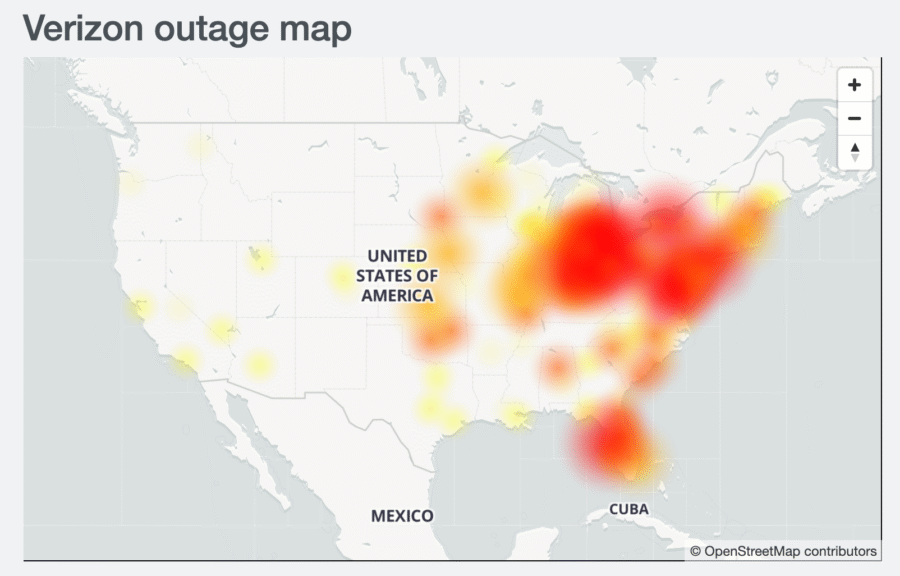Click here to buy secure, speedy, and reliable Web hosting, Cloud hosting, Agency hosting, VPS hosting, Website builder, Business email, Reach email marketing at 20% discount from our Gold Partner Hostinger You can also read 12 Top Reasons to Choose Hostinger’s Best Web Hosting
A sudden verizon network outage left many customers without calls or texts and some phones stuck in “SOS” mode — a real problem for people who depend on mobile service for work, family and safety. The frustration doubled when community posts and outage maps showed thousands affected and corporate updates were short on detail, increasing uncertainty for businesses and parents alike. This article explains what Verizon publicly said, how the outage appears to have unfolded, immediate fixes you can try, and the practical fallback plans (for individuals and small organizations) that limit damage when a carrier goes dark.
What happened
On August 30–31, 2025, large pockets of Verizon’s wireless network experienced widespread disruptions across multiple U.S. cities. Verizon told customers it was “aware of a software issue impacting wireless service for some customers” and said engineers were working to identify and resolve the problem — encouraging users to check the company’s network-status pages for updates.

Third-party outage trackers and social posts showed reports peaking in the tens of thousands at the outage’s height; many users described phones showing “SOS” or limited connectivity even while cellular signal bars disappeared.
16 Billion Passwords Leaked – Here’s Why You Should Care and What to Do Next
Why this matters
Everyday life: People couldn’t call taxis, order deliveries, or confirm appointments. For caregivers and families, lost reachability creates stress.
Small businesses: Retailers and freelancers relying on mobile point-of-sale (POS) or authentication (2FA) faced payment delays and lost sales.
Emergency services & trust: Repeated carrier outages chip away at confidence in primary communications infrastructure — regulators and enterprise customers pay attention.
Technical signal: Verizon’s use of the phrase “software issue” points to a configuration or platform change rather than a physical-cut fiber event — these are often fast to fix but can affect many systems at once.
Quick fixes that actually help (step-by-step)
If you’re currently affected, try these in order — they fix most device-side issues and restore temporary connectivity.
Toggle Airplane mode on, wait 15 seconds, toggle it off.
Forces the radio to re-register with the carrier and can clear transient registration problems.
Restart your phone.
A full reboot refreshes network stacks and often resolves SOS/limited-service states.
Enable Wi-Fi Calling (if available) and connect to a trusted Wi-Fi network.
This immediately restores calls and texts for most devices while the mobile network is impaired.
If you use an iPhone: reset network settings (Settings → General → Transfer or Reset → Reset → Reset Network Settings) only if other steps fail.
Warning: this removes saved Wi-Fi passwords; use as last resort.
Use messaging apps over Wi-Fi (WhatsApp, Signal, Telegram) to reach contacts.
These bypass the carrier for text and voice, useful when SMS is down.
Switch SIM / use an eSIM (if your phone supports it) or borrow another carrier’s phone — useful for urgent calls.
Many modern phones support activating a second carrier profile quickly.
Check Verizon’s network-status pages or your account alerts for targeted updates.
Practical steps for small businesses and shops
Situation: A neighborhood cafe uses a mobile-first POS. During the outage, card payments fail and orders stack up.
Workarounds that worked for them:
Switched to offline card mode in the POS app (accepted payments and later batched).
Opened a temporary cash lane with clear signage and a short apology script.
Maintained a preprinted QR code for contactless ordering (orders processed when connectivity returned).
Notified customers via the café’s Wi-Fi landing page and social profiles.
Takeaway: A short, visible fallback (offline payments + honest signage) reduces customer friction and losses; test offline modes monthly.
16 Billion Passwords Leaked – Here’s Why You Should Care and What to Do Next
Outage resilience is now a user-experience problem
Most coverage rightly treats outages as engineering incidents. But here’s a perspective rarely emphasized: carrier downtime is increasingly a product-design and customer-experience problem.
Vendors building apps and devices must design assuming intermittent connectivity: graceful degradation, offline-first workflows, and local data caches matter.
UX designers should craft clear UI states for “no carrier” — not just obscure error codes. A clear “SOS mode — try Wi-Fi calling” banner reduces panic.
For enterprises, it’s not enough to buy a single “reliable” carrier — SLA thinking must extend to multi-SIM hardware, fixed broadband failover, and push-to-talk fallbacks.
If product teams bake in outage-mode UX and operational readiness, customers feel supported rather than abandoned when networks fail.
Longer-term implications and what to watch next (analysis & forecast)
Regulatory questions: Repeated major outages raise conversations at the FCC and among state public-utility regulators about disclosure, redundancy, and reporting timelines. Expect hearings or information requests if damage is widespread.
Enterprise contracts: Large customers may demand clearer incident reporting and credits; carriers will need better post-mortems to retain B2B trust.
Network architecture scrutiny: Outages labeled as “software issues” will push carriers to invest in safer deployment practices — staged rollouts, stronger rollback plans, and automated verification tests.
User behavior change: Repeated pain points may accelerate multi-SIM adoption, eSIM portability, and the market for independent mobile connectivity monitors.
Opinion (clearly labeled): Carriers that communicate faster and provide meaningful status dashboards (not just “we’re aware”) will win customer loyalty after an outage. Transparency matters more than a polished PR statement.
Key Takeaways
Verizon acknowledged a software-related wireless disruption and directed customers to network-status pages. Verizon+1
Immediate user fixes: toggle airplane mode, restart, enable Wi-Fi calling, use messaging apps or a secondary SIM.
Businesses should test offline payment workflows and have visible fallback signage.
Outages are now a UX and product-design problem — building for intermittent connectivity reduces harm.
Expect regulatory scrutiny and stronger SLAs for enterprise customers if outages become recurrent.
Is ChatGPT Down? How to Check the Outage, What OpenAI Says, and What to Do Next
FAQs (People Also Ask)
Q: How long does a typical carrier software-related outage take to fix?
A: It varies. Software-rollout issues can be fixed in minutes to hours if a rollback or hotfix works. Complex configuration errors can take longer. Carriers usually update status pages as engineers make progress.
Q: Why does my phone show “SOS” during a verizon outage?
A: “SOS” means your phone can make emergency calls (via any available network) but cannot register fully with your carrier for normal services. Rebooting and re-registering often clears it.
Q: Does enabling Wi-Fi calling always solve the problem?
A: If the outage affects the mobile radio only and you have working Wi-Fi, Wi-Fi calling allows calls/texts to use internet connectivity. It requires your device and account to support Wi-Fi calling.
Q: Should I switch carriers after repeated outages?
A: Consider your personal risk profile. For mission-critical use (business continuity, caregiving), adding a second carrier (physical SIM or eSIM) and testing failover is prudent. Before switching, compare coverage maps, SLA terms (for enterprise), and customer incident handling.
Conclusion — what you can do right now
If you’re affected: try the quick fixes above and enable Wi-Fi calling. If you run a small business, test your POS offline flow this week and prepare a simple customer-facing script and signage for the next outage. For deeper reading, check our SmashingApps guide on preparing for mobile outages and subscribe for timely breakdowns and how-to templates that save time when connectivity fails.
Bookmark Verizon’s network-status page and set a calendar reminder to rehearse your outage plan — a 10-minute test can save hours of lost revenue.
Now loading...






